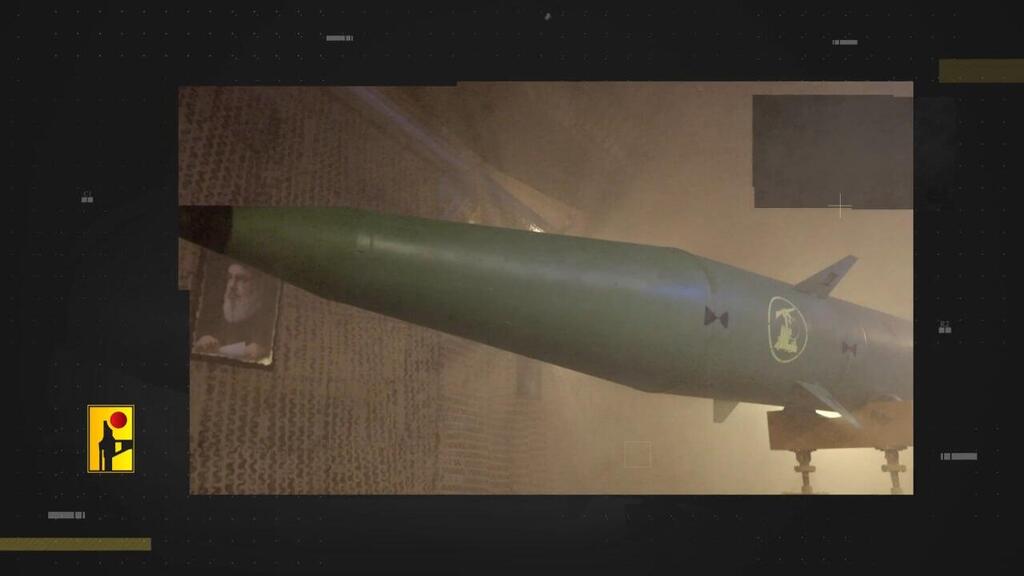Getting your Trinity Audio player ready...
Hezbollah has unveiled a video showcasing the features of the Qader 1 surface -to-surface ballistic missile – the first of its kind to be launched from Lebanese soil toward central Israeli cities. The David's Sling aerial defense system intercepted the missile, resulting in no casualties or damage. According to the Shiite terrorist organization in its video released on Wednesday evening, this surface-to-surface missile boasts a range of 118 miles. The missile's total weight is 2.87 tons, with a warhead weighing 1,100 lbs. Hezbollah claims that it is a tactical ballistic missile with high destructive capability, capable of maneuvering mid-flight and striking targets with precision.
Qader-1 missile
At 6:30 a.m. on Wednesday, sirens echoed through Tel Aviv, Glilot, Ramat Gan, Netanya and other central Israeli cities. Shortly after, the missile launched from Lebanon was intercepted. About half an hour following the launch, the Home Front Command confirmed there were no changes in directives for the center o9f the country, and schools in areas where sirens sounded would operate as usual.
Hezbollah claimed responsibility for the launch, stating in their announcement that a Qader 1 ballistic missile was fired at the Mossad headquarters – the site allegedly responsible for the explosion of Hezbollah beepers and communication devices, as well as the elimination of senior terror organization members. The Saudi television channel Al-Hadath reported, based on its sources, that "Hezbollah attempted to send a message by launching a single ballistic missile at Tel Aviv. The launch occurred simultaneously with an attack on October 7," meaning at 6:29 a.m.
Residents of Netanya have grown accustomed to a life without sirens. The last time an alert was activated in the city was during Operation Guardian of the Walls in 2021. However, on Wednesday morning, residents were startled by sirens echoing through the city, waking many at an early hour.
"I woke up in a panic and ran with the kids to the shelter," shared Michal Nechmani, a resident of the city's southern neighborhoods. "Since the war started, we haven’t had a siren, so we were calm, thinking it wouldn’t reach us. People always joked that Hamas and Hezbollah are afraid of people in Netanya. This morning we realized that’s not the case. There were moments of fear, but we quickly understood there were no casualties, and they were holding school – so we returned to our routine."
Meanwhile, social media platforms were flooded with posts and humorous remarks. "The Netanya municipality has asked residents not to get involved. This is between the IDF and Hezbollah," read one post. "I don't understand where Nasrallah got the nerve to shoot at Netanya," another post quipped, along with a sarcastic message to criminal elements: "So, what are we paying you such high protection fees for?"
Also on Wednesday, Iran-backed militias in Iraq, operating under the moniker Islamic Resistance in Iraq, published footage of the launch of the two UAVs aimed at Eilat. One of them exploded in the city's port, causing minor injuries to two residents, and the other was intercepted by the Israeli Navy in the skies over the Red Sea.
A video of the launch of the UAVs to Eilat by the Islamic Resistance in Iraq
According to sources identified with the militias, the UAVs that were launched are of the Iranian model Shahed 131, a model that is also used by Russia in its attacks on Ukraine. According to reports, this is an attack UAV manufactured by Iran's Revolutionary Guards. Its weight reaches 135 kg, its length is 2.6 meters and its wingspan is 2.2 meters. The warhead of the UAV weighs 15 kg, and it is claimed that it can reach ranges of 900 to 1,000 km.







